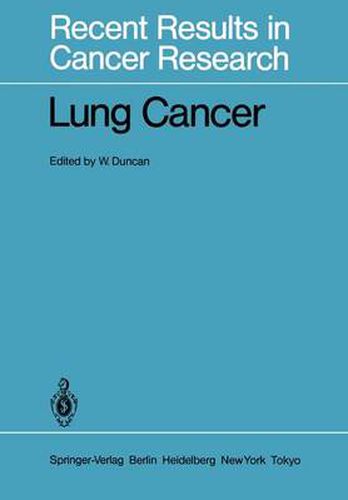Readings Newsletter
Become a Readings Member to make your shopping experience even easier.
Sign in or sign up for free!
You’re not far away from qualifying for FREE standard shipping within Australia
You’ve qualified for FREE standard shipping within Australia
The cart is loading…






This title is printed to order. This book may have been self-published. If so, we cannot guarantee the quality of the content. In the main most books will have gone through the editing process however some may not. We therefore suggest that you be aware of this before ordering this book. If in doubt check either the author or publisher’s details as we are unable to accept any returns unless they are faulty. Please contact us if you have any questions.
Each year a multidisciplinary symposium on Clinical Oncology is organised by the Royal College of Radiologists in London. The fifth symposium was held in February 1983 when the subject was Lung Cancer. The clinical and social importance of lung cancer cannot be too greatly stated. The disease is an enormous cause of morbidity and remains the most common cause of death from cancer in males in the Western World. Sadly, the incidence of the disease continues to increase in women in the United Kingdom, and the success of commercial pressure to encourage cigarette smoking in the developing countries must mean that an increasing community health problem may be anticipated. The methods used to promote cigarette smoking are dramatically described in this publication. The enormous weight of vested interest in tobacco consumption makes education of the public and of politi cians about the health hazards of smoking a formidable battle waged with very limited resources. Attitudes can be changed by skilled professional groups, but they do require much greater international support. The prognosis of patients with lung cancer remains extremely poor. Optimum management requires expert pretreatment assessment and careful selection of the many forms of treatment available. The techniques of clinical assessment and staging, radiological investiga- Preface VI tion, and pathological classification are all described in some detail and their limitations are well illustrated. It is hoped that meetings of this kind will stimulate the further collaboration of multidisciplinary groups to improve our understanding of these aggressive diseases.
$9.00 standard shipping within Australia
FREE standard shipping within Australia for orders over $100.00
Express & International shipping calculated at checkout
This title is printed to order. This book may have been self-published. If so, we cannot guarantee the quality of the content. In the main most books will have gone through the editing process however some may not. We therefore suggest that you be aware of this before ordering this book. If in doubt check either the author or publisher’s details as we are unable to accept any returns unless they are faulty. Please contact us if you have any questions.
Each year a multidisciplinary symposium on Clinical Oncology is organised by the Royal College of Radiologists in London. The fifth symposium was held in February 1983 when the subject was Lung Cancer. The clinical and social importance of lung cancer cannot be too greatly stated. The disease is an enormous cause of morbidity and remains the most common cause of death from cancer in males in the Western World. Sadly, the incidence of the disease continues to increase in women in the United Kingdom, and the success of commercial pressure to encourage cigarette smoking in the developing countries must mean that an increasing community health problem may be anticipated. The methods used to promote cigarette smoking are dramatically described in this publication. The enormous weight of vested interest in tobacco consumption makes education of the public and of politi cians about the health hazards of smoking a formidable battle waged with very limited resources. Attitudes can be changed by skilled professional groups, but they do require much greater international support. The prognosis of patients with lung cancer remains extremely poor. Optimum management requires expert pretreatment assessment and careful selection of the many forms of treatment available. The techniques of clinical assessment and staging, radiological investiga- Preface VI tion, and pathological classification are all described in some detail and their limitations are well illustrated. It is hoped that meetings of this kind will stimulate the further collaboration of multidisciplinary groups to improve our understanding of these aggressive diseases.